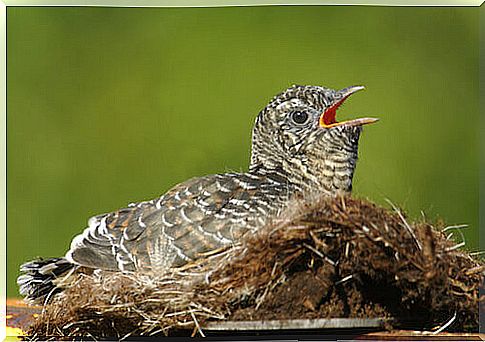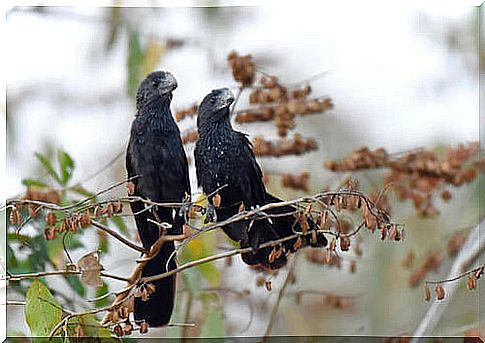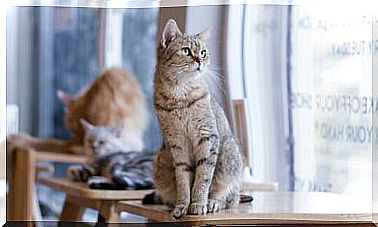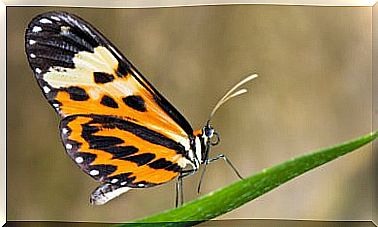The Cuckoo, A Cunning And Cruel Bird

The cuckoo is a bird belonging to the family of Cuculidi , which includes this bird and his other relatives. This type of birds live mainly on trees, although some species are more terrestrial and develop more legs than wings, as in the case of road runners or roadrunners ( Geococcyx californianus Lesson , 1829).
Beyond their morphological characteristics, what makes some birds of this family special is their nature as parasites. In particular, cuckoos are known to lay their eggs in the nests of other birds.
The singing cuckoo (Cuculus canorus), the most astute of the cuckoos
In the world, there are many species of cuckoos. But only those who live in Eurasia and Africa have the bad habit of exploiting the nests of other birds to lay their eggs.
The cuckoos of the American continent build their nests and take care of their chicks. It is the European cuckoos who prefer to entrust their offspring to the care of other birds: larks, parulids, wrens, robins and many other passerines.
The choice of the bird family that will look after the cuckoo chicks depends on the color of their eggs. The different species of cuckoo have been able to evolve in such a way that their eggs resemble those of the species to which they will entrust them. In this way, the risk of rejection by the “adoptive mother” is avoided.
Information on the cuckoo and its relatives
The common cuckoo ( Cuculus canorus ) is a migratory bird that heralds the arrival of spring and is the parasite par excellence of other birds. This bird announces the arrival of the spring season with its song.
The cuckoo is massively present in the Black Forest in Germany, the country where the cuckoo clock was invented. Will it be a coincidence?

What does it mean to be a parasite on other birds’ nests?
The extraordinary way in which the cuckoo ensures the survival of its young is now well known. The female cuckoo watches other birds build their nests until the future “adoptive mother” (and owner of the nest) lays her eggs.
At this point, the female cuckoo takes advantage of the bird’s absence to get rid of the eggs of the rightful owner of the nest and lay her own before the bird returns. In this way the other female will unwittingly raise a chick that is not hers.
The cuckoo egg hatches after twelve days, often earlier than its nest mates. The young cuckoo takes advantage of this advantage to throw everything around him into the void.
Perhaps, it is precisely this course of action that has given this bird a bad name. The reality, unfortunately, is that the rest of the chicks cannot compete with a “brother” who grows faster than them and who consumes all the food provided by the mother.
How does the young cuckoo manage to take control of the nest?
The young cuckoo tries with its wings to put the eggs or small chicks on its back to throw them out of the nest. Or, it pushes the other chicks towards the edge with its paws and then later throws them into the void. To get rid of nest mates, the little cuckoo will repeat these actions as many times as necessary.
To eliminate all the eggs or other chicks, the young cuckoo takes a lot of energy and will take several days to complete his feat. Sometimes, his attempts fail. However, if he succeeds, the cuckoo chick will grow so fast that in no time he will be able to fend for himself. After only three weeks, the “baby” is able to leave the nest and fly away.
What about the rest of the Cuculidae?
It is believed that only Old World cuckoos are the only ones to have these parasitic customs. In addition to the common European cuckoo, the crested cuckoo ( Clamator glandarius ) also has the same behaviors. Typically, this bird lays its eggs in the nests of magpies and starlings.
Beyond the best-known examples, it is non-parasitic cuckoos that attract the most attention. Usually, they build their nests and both parents hatch and feed the chicks. Let’s see together how Crotophaga ani and Geococcys californianus behave .
The Crotophaga ani , one of the cuckoo’s more sociable relatives
The Crotophaga ani is a bird that lives in a territory ranging from the United States to Panama, the Caribbean and almost all of South America. It is a gregarious species that lives in community. Even if it forms pairs to reproduce, it always lives in very noisy groups. These birds prefer open territories and cultivated areas.
They fly in flocks of about twenty individuals and even when they raise their chicks, they remain in groups. They build large common nests that the females use to lay eggs which all hatch together at the same time. Meanwhile, the rest of the group members complete the construction of the nest or repair it.

The Geococcys californianus , the roadrunner cartoon
The Geococcys californianus , better known as the roadrunner is a bird that lives in the drylands and deserts of the United States of America and Mexico. As children also know, the roadrunner is a bird that is not very suitable for flying, but it can run very fast.
This bird can reach speeds of 25 kilometers per hour. Its short, sturdy legs move so fast that they never seem to touch the ground.

Now you know that not all cuckoos are parasites. The roadrunner and Crotophaga ani I am a living example.









